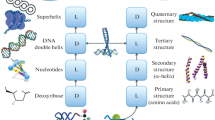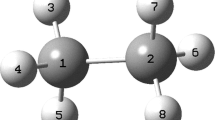Abstract
The theory of chirality functions described in a previous publication is generalized to allow for chiral ligands. In the earlier theory, all symmetry operations of the molecular frame could be thought of as permutations of the ligands among the sites; in the present work, improper rotations not only permute the ligands, but convert them into mirror images. The group that generates all isomers from a given ordered molecule belonging to a frame with n sites is now the “hyperoctahedral” group of order 2n n! consisting of all possible combinations of permutations and site reflections. The representation theory of these groups is described, and applied to the problem of constructing qualitatively complete chirality functions, and of deciding which ligand partitions, and which isomer mixtures, are chiral. It is found useful to classify chiral representations of the covering group as “ligand specific” and “class specific”. The ligand specific representations describe chiral properties which are common to all frames and arise purely from the chirality of the ligands, while the class specific representations describe the chiral properties of the frame. A number of examples are explicitly worked out.
Similar content being viewed by others
References
Boerner,H.: Darstellungen von Gruppen, zweite Auflage. Berlin: Springer Verlag 1967. English Translation: Representations of groups, 2'nd Edition. Amsterdam: North Holland Publishing Co., 1970. The foll owing chapter and page numbers refer to the second German edition: (a) Kap. II.2, pp. 28–9; (b) Kap. III, Satz 3.9, p. 58; (c) Kap. IV, Satz 2.5, p. 106; (d) Kap. IV, Satz 2.8, 2.9, p. 107; (e) Kap. IV, Satz 2.1, p. 104; (f) Kap. III, Satz 3.8, p. 58; (g) Kap. IV, Satz 3.2, p. 109; (h) Kap. IV, p. 110; (i) Kap. IV, Satz 4.4, p. 111; (j) Kap. III.4, pp. 60–67; (k) Kap. III, Satz 13.1, p. 92.
Frame,J.S.: Nagoya Math. J. 27, 585 (1966).
Haase,D., Ruch,E.: Theoret. chim. Acta (Berl.) 29, 189 (1973).
Haase,D., Ruch,E.: Theoret. chim. Acta (Berl.) 29, 247 (1973).
Hamermesh,M.: Group theory. Reading, Mass.: Addison-Wesley, 1962. Ch. 7–12, pp. 249–54
Hamermesh,M.: Group theory. Reading, Mass.: Addison-Wesley, 1962. Ch. 1–5, pp. 24–6.
Kerber,A.: Representations of permutation groups I. Berlin: Springer Verlag 1971.
Littlewood,D.E.: The theory of group characters. Oxford: Oxford University Press 1950.
Ruch,E.: Theoret. chim. Acta Berl. 11, 183 (1968).
Ruch,E., Schönhofer,A.: Theoret. chim. Acta Berl. 3, 291 (1965).
Ruch,E., Schönhofer,A.: Theoret. chim. Acta Berl. 19, 225 (1970).
Young,A.: Proc. London Math. Soc. (2) 31, 273 (1930).
Author information
Authors and Affiliations
Rights and permissions
About this article
Cite this article
Mead, A., Ruch, E. & Schönhofer, A. Theory of chirality functions, generalized for molecules with chiral ligands. Theoret. Chim. Acta 29, 269–304 (1973). https://doi.org/10.1007/BF00529053
Received:
Issue Date:
DOI: https://doi.org/10.1007/BF00529053




